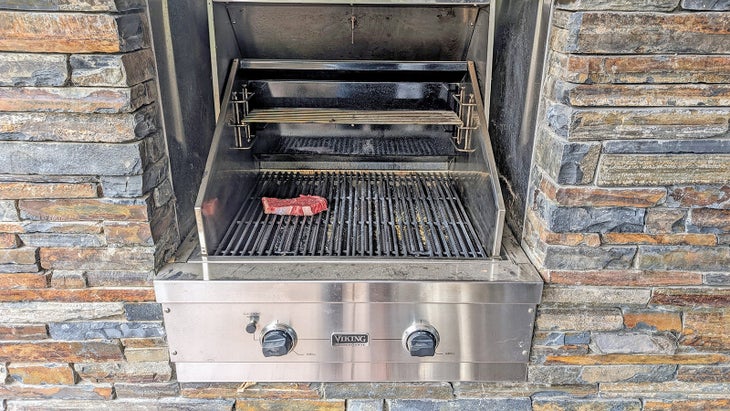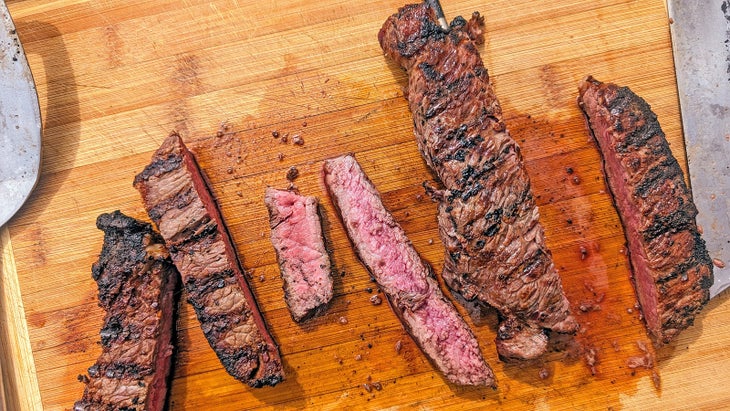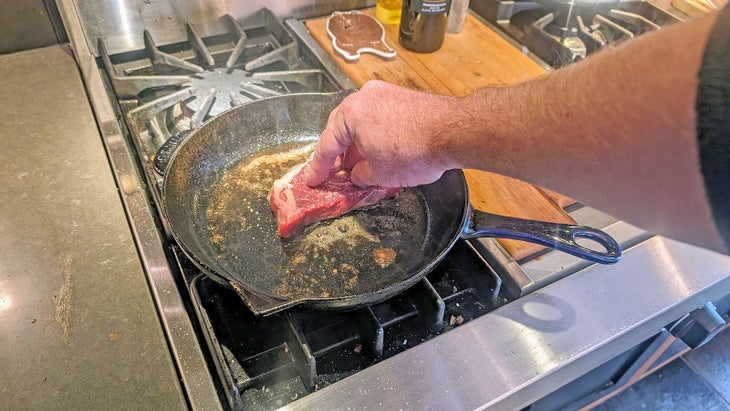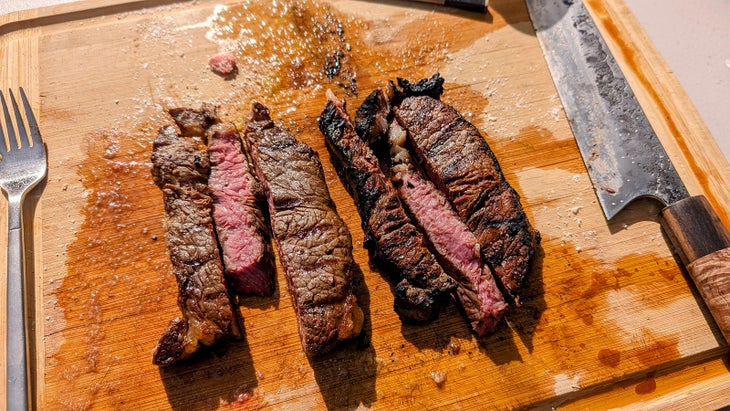What’s the best way to grill a steak? There’s no one answer, but to me, there’s always been a wrong one. I’ve long considered grilling with gas to be heresy, but it occurred to me that I’d never actually done a back-to-back taste test between gas and charcoal. Earlier this week, with very excited dogs, I fired up my grills and got down to work.
What’s the difference? Temperature, smoke, and convenience. While natural lump charcoal is able to get much hotter than natural gas or propane, and produces delicious wood smoke, it also takes time to light and bring up to temperature, is messy to use, and can be challenging for beginners to precisely control. In comparison, on a gas grill you simply turn dials and push a button to ignite the flame.
The Experiment: How to Grill a Steak
To control for variables as much as possible, I bought four identical choice-grade New York strip steaks. Not the expensive ribeyes I normally cook, they were maybe half-an-inch thick, and not terribly well marbled. Then, I set out to conduct two tests. First, a cook using the most basic methods possible. I wanted to eliminate any flavor difference created by ultra-hot sears, and just experience the difference in flavor, if any, between fuels. Then, I wanted to take advantage of charcoal’s high temperatures to see if the end result really is superior.
Pulling two steaks out of the butcher paper, I liberally coated each in kosher salt, then set them aside to come up to room temperature. According to Bon Appétit, allowing a steak to lose its chill before cooking results in a more even temperature and juicier results.

Grilling Steak: Gas Versus Charcoal
I fired up both burners on my patio’s built-in Viking grill (it came with the house), and let it heat up on full blast for 15 minutes. 550 degrees was the highest achievable temperature, so I inserted my Meater+ wireless thermometer in the steak, and threw it on the grill, being careful to leave the hood open. The wired probe on my Dot thermometer was throwing error codes and needs to be replaced, and the hottest ambient temperature the Meater+ can withstand is 500 degrees. Leaving the hood open may have allowed some heat to escape, but it also allowed me to monitor the steak’s internal temperature precisely.
When the steak reached 110-degrees internal, I flipped it over, then pulled it off at 125, setting it aside to rest while I heated up my Big Green Egg (BGE). To make things fair, I also set it to 550 degrees, and left the lid open while I followed the same method.

And the Winner Is…
I actually think I overcooked the BGE’s steak slightly. While resting, the gas steak reached a high temperature of 132. The BGE’s reached 136. And you can see that in the side-by-side shots, where the gas steak looks a little more evenly pink throughout.
The difference was stark upon tasting. While an unpleasantly sour taste pervaded every bite of the steak grilled on the Viking, the one grilled on natural lump charcoal just tasted like salt, fat, and heat. I’d have needed dollops of sauce to finish the gas steak, but could have eaten the charcoal one on its own with a reasonable level of enjoyment.
While many experts argue that natural gas or propane grills burn their fuels without odor, I’ve never found the taste they produce in steaks palatable. I don’t know if that’s simply because I prefer the taste of wood-smoke in steak to steak without the smoke, but I do know I can taste a difference.

With the aid of a leaf blower, I’m able to take my BGE above 1,500 degrees (this is also very dangerous and is best left to experienced grillers). Of course, that’s only with natural lump charcoal, which contains nothing but carbonized wood, rather than the compacted sawdust briquettes that are filled with chemical additives. You don’t necessarily need a multi-hundred-dollar Egg to achieve a perfect steak; just burning natural lump in a standard kettle grill will elevate your flavors, while also facilitating higher temperatures.
Would results differ if I used a more elaborate method, and is it possible to hide the flavor of gas? My go-to grilling method for steak is to do the hottest-possible sear on the front end, rest the steaks for at least 20 minutes, then put them back on at a low temperature to cook through. At home, I use that Big Green Egg for the sear, then rely on the more consistent temperatures of a pellet grill for the slow cook through. But that method often works just as well on lesser equipment.

Don’t Have a Charcoal Grill? Fear Not.
Because butter withstands higher temperatures than olive oil, and also because I was hoping its sweet flavor could mask the sour aftertaste created on the gas grill, I first salted then seared one of the steaks on my 24,000 BTU Viking range burner, using a Staub enameled cast iron pan. With that pre-heated as hot as possible, I melted some butter, then cooked the steak for a minute on each side, before moving it to a cool cutting board to rest.
To sear on the Big Green Egg, I simply point a leaf blower at the intake from a few feet away, then watch the thermometer dial spin around as a wall of flame emerges from the top. 30 seconds on each side produced a very crispy sear on this strip. I also rubbed the steak with a good quality olive oil first, to seal in moisture.
After allowing both steaks to rest for 20 minutes, I threw them back on their respective grills, with both of those set at 250 degrees, to cook through to 125. Then rested each again for 10 minutes to come up to something north of 130 before slicing. I again think I slightly overdid the steak on the Egg, simply because I’m not used to cooking such thin pieces of beef.

The Bottom Line: Just Avoid Gas
With this method, the gas grill produced a more predictable result, but the sear was lackluster and the flavor of the gas was not dissipated at all, even with all that butter. The charcoal steak was a little overdone, but a lot more palatable anyways.
I’ll go back to reserving my gas grill for occasional vegetable-only duty during big dinner parties, and keep my meats as far away from gas-fired grills as possible. Still, the dogs didn’t seem to care which steak they were given. All four disappeared in only a few quick chomps.
"food recipes" - Google News
May 21, 2024 at 01:00PM
https://ift.tt/iOBFcgl
How to Grill Steak the Right Way - Outside
"food recipes" - Google News
https://ift.tt/czwAKTQ
https://ift.tt/9m7OMgG
Bagikan Berita Ini















0 Response to "How to Grill Steak the Right Way - Outside"
Post a Comment